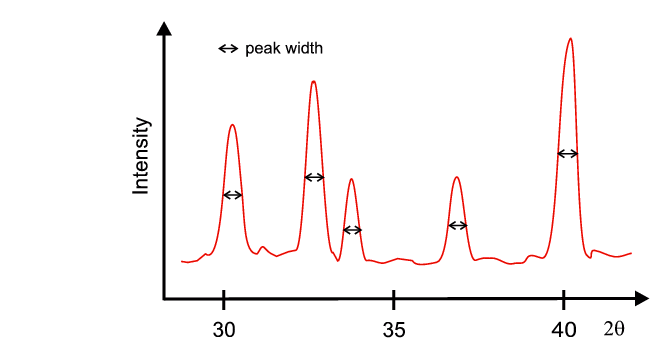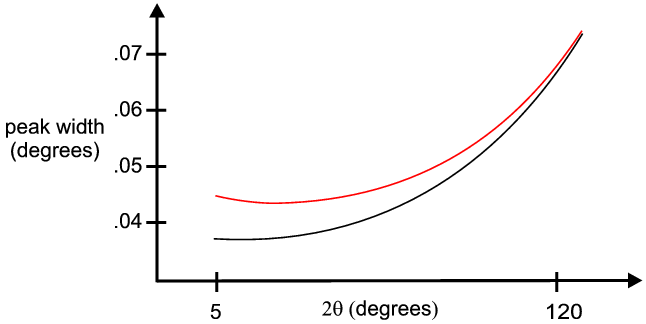 |
Introduction to Synchrotron Powder
Diffraction |
 Course Material Index
Course Material Index
 Section Index
Section Index
 Previous Page
Previous Page
 Next Page
Next Page
Introduction to Synchrotron Powder
Diffraction
Before considering specific modes of synchrotron powder diffraction we
need to discuss a few generalities.
We should first ask what it is that sets synchrotron powder diffraction apart
from powder diffraction practised in the laboratory? Here are four possible
suggestions:
-
choice of mode: monochromatic (angle-scanning) or white radiation (see:
Introduction to Powder Diffraction, Laue Versus Monochromatic Methods if you
need a reminder of the meaning of the angle-scanning mode)
-
choice of wavelength from a continuous X-ray spectrum
-
intense X-ray beam (leading to superior statistics/speed)
-
better spatial precision of the incident/diffracted X-ray beams (i.e.
resolution).
The last item results from all the various factors considered earlier: whereas
in laboratory powder diffraction the intensity is spread over a relatively
divergent beam, synchrotron powder diffraction concentrates the intensity into
a fine well-defined near-parallel X-ray beam. One way this is manifested is in
the nature of the Full Width Half Maximum: the width of the powder
diffraction peaks in the pattern at half their maximum height measured as a
function of 2θ (see below).
 The smaller the peak width, the sharper the peaks and the better
resolved the pattern (i.e less overlap of neighbouring peaks). However
it is found that the peak widths vary with angle even in a single pattern. If
we were to plot the peak width against the angle 2θ, we would get curves
like those shown below:
The smaller the peak width, the sharper the peaks and the better
resolved the pattern (i.e less overlap of neighbouring peaks). However
it is found that the peak widths vary with angle even in a single pattern. If
we were to plot the peak width against the angle 2θ, we would get curves
like those shown below:
 From this we can see that generally speaking the peak width increases with
angle 2θ (see black curve). This is due to the spread in wavelength
(δλ/λ); i.e. the beam is not perfectly monochromatic. In
some cases there can also be a small increase in peak width at low
2θ-angles (see red curve) arising from factors
such as sample size, beam size (defined by the beam slits) and misalignment of
the diffractometer axis.
From this we can see that generally speaking the peak width increases with
angle 2θ (see black curve). This is due to the spread in wavelength
(δλ/λ); i.e. the beam is not perfectly monochromatic. In
some cases there can also be a small increase in peak width at low
2θ-angles (see red curve) arising from factors
such as sample size, beam size (defined by the beam slits) and misalignment of
the diffractometer axis.
Many powder diffractionists have turned to synchrotron powder
diffraction for its superior resolution. This superiority is due mainly to
two properties of the synchrotron beam:
-
the great intensity of the beam arriving at the monochromator. This means that
the monochromator can be made highly wavelength selective, i.e. we can afford
to reject most of the incoming beam and still have a sufficiently intense
monochromatic beam.
-
the nearly parallel beam, which removes the need for focussing geometry with a
flat plate sample. Since focussing geometry is inaccurate at low angles, this
eliminates a significant source of low angle peak broadening found in
conventional laboratory diffractometer data.
However this is not the only important parameter implicated in the quality of a
powder diffraction pattern; other parameters where the synchrotron is an
improvement over conventional laboratory sources are:
-
better counting statistics (i.e. more intense peaks) due to the intensity of
the synchrotron beam, leading to better signal:noise ratio;
-
better peak:background ratio for certain samples; the tuneable wavelength
enables the user to avoid background fluorescence, which can be a problem where
conventional laboratory sources are used with only a pre-sample monochromator.
(Fluorescence from iron rich samples in a Cu Kα beam is a
particularly common instance of this.)
During the remainder of this section we will briefly discuss some of the
various modes of powder diffraction that can be implemented on a synchrotron.
 Course Material Index
Course Material Index
 Section Index
Section Index
 Previous Page
Previous Page
 Next Page
Next Page



